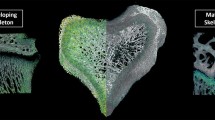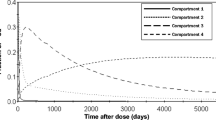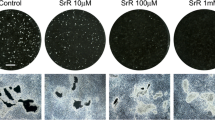Summary
Gallium, a group IIIa metal, is known to interact with hydroxyapatite as well as the cellular components of bone. In recent studies we have found gallium to be a potent inhibitor of bone resorption that is clinically effective in controlling cancer-related hypercalcemia as well as the accelerated bone resorption associated with bone metastases. To begin to elucidate gallium's mechanism of action we have examined its effects on bone mineral properties. After short-term (14 days) administration to rats, gallium nitrate produced measurable changes in bone mineral properties. Using atomic absorption spectroscopy, low levels of gallium were noted to preferentially accumulate in regions of active bone formation, 0.54±.07 μg/mg bone in the metaphyses versus 0.21±.03 μg/mg bone in the diaphyses,P<0.001. The bones of treated animals had increased calcium content measured spectrophotometrically. Rats injected with radiolabeled calcium during gallium treatment had greater 45-calcium content compared to control animals. By wide-angle X-ray analyses, larger and/or more perfect hydroxyapatite was observed. The combined effects of gallium on bone cell function and bone mineral may explain its clinical efficacy in blocking accelerated bone resorption.
Similar content being viewed by others
References
Chun H, Bockman RS, Boskey AL, Alcock NW, Warrell RP Jr (1984) Gallium nitrate treatment alters the resorbability of bone. Calcif Tissue Int (abstract) 36:456
Warrell RP Jr, Bockman RS, Coonley CJ, Isaacs M, Staszewski HJ (1984) Gallium nitrate inhibits calcium resorption from bone and is effective treatment for cancer-related hypercalcemia. J Clin Invest 73:1487–1490
Warrell RP Jr, Isaacs M, Coonley CJ, Alcock NW, Bockman RS (1985) Metabolic effects of gallium nitrate administered by prolonged infusion. Cancer Treatment Reports 69(6):653–655
Bockman RS, Boskey A, Alcock N, Warrell RP Jr (1985) Gallium nitrate inhibits bone resorption, increases bone calcium content but is not cytotoxic to bone cells. ASBMR Abstract A30
Bockman RS, Warrell RP, Alcock NW, Boskey AL, Skelos A (1985) Gallium blocks accelerated bone resorption in patients with metastatic cancer and increases calcium content of bone. Clin Res 33:576A
Farley JR, Wakely GK, Tarbaux N, Baylink DJ (1986) Low doses of gallium affect thymidine incorporation by bone cells in vitro. Clin Res 34:58A
Anghileri L (1971) Studies on the accumulation mechanisms of radioisotopes used in tumor scanning. Strahlentherapie 142:456–462
Bockman RS, Warrell RP Jr, Alcock NW, Boskey AL, Skelos A (1985) Gallium blocks accelerated bone resorption in patients with metastatic cancer and increases calcium content of bone. Clin Res 33:576A
Kelsen DP, Alcock NW, Yeh S, Brown J, Young CW (1980) Pharmacokinetics of gallium nitrate in man. Cancer 46:2009–2013
Heinonen JK, Lahti RJ (1981) A new and convenient colorimetric determination of inorganic orthophosphate and its application to the assay of inorganic pyrophosphatase. Analytical Biochem 113:313–317
Termine JD, Posner AS (1966) Infrared analysis of rat bone: age dependency of amorphous and crystalline fractions. Science 153:1523–1525
Blumenthal NC, Posner AS, Holmes JM (1972) Effect of preparation conditions on the properties and transformation of amorphous calcium phosphate. Mater Res Bull 7:1181–1190
Termine JD, Eane ED (1972) Comparative chemistry of amorphous and apatite calcium phosphate preparations. Calcif Tissue Res 10:171–197
Posner AS, Betts F, Blumenthal NC (1979) Bone mineral composition and structure. In: Kunin A, Simmons D (eds) Skeletal research. Academic Press, New York, pp 67–192
Boskey AL, Marks SC (1985) Mineral and matrix alterations in the bones of incisor-absent (ia/ia) osteopetrotic rats. Calcif Tissue Int 37:(3) 287–292
Cullity BD (1967) Elements of x-ray diffraction. Addison Wesley, Reading Maine, pp 97–99
Hart MM, Adamson RH (1971) Antitumor activity and toxicity of salts of inorganic group IIIa metals: aluminum, gallium, indium, and thallium. Proc Nat Acad Sci USA 68:1623–1626
Boskey AL, Posner AS (1984) Bone structure, composition, and mineralization. Orthop Clin North Am 15:597–613
Thompson DD, Posner AS, Laughlin WS, Blumenthal NC (1983) Comparison of bone apatite in osteoporotic and normal Eskimos. Calcif Tissue Int 35:392–393
Schraer H, Tannenbaum PJ, Posner AS (1967) Crystalline changes in avian bone related to the reproduction cycle. J Dent Res 46:1072–1974
Author information
Authors and Affiliations
Rights and permissions
About this article
Cite this article
Bockman, R.S., Boskey, A.L., Blumenthal, N.C. et al. Gallium increases bone calcium and crystallite perfection of hydroxyapatite. Calcif Tissue Int 39, 376–381 (1986). https://doi.org/10.1007/BF02555174
Received:
Revised:
Issue Date:
DOI: https://doi.org/10.1007/BF02555174




